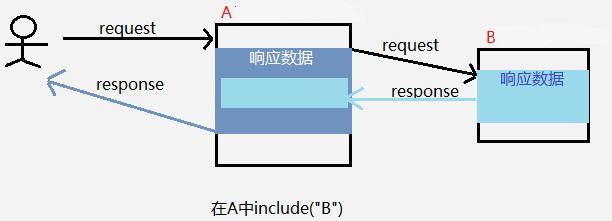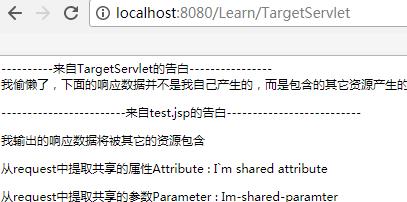关于RequestDispatcher的原理
Posted lulipro - 代码钢琴家
tags:
篇首语:本文由小常识网(cha138.com)小编为大家整理,主要介绍了关于RequestDispatcher的原理相关的知识,希望对你有一定的参考价值。
RequestDispatcher简介
public interface RequestDispatcher { public void forward(ServletRequest request, ServletResponse response) throws ServletException, IOException; public void include(ServletRequest request, ServletResponse response) throws ServletException, IOException; }
RequestDispatcher.forward(request, response)
public class User{ private String name; private int age; public String getName(){ return name ; } public void setName( String name ){ this .name = name ; } public int getAge() { return age ; } public void setAge( int age ){ this .age = age ; } }
UsersServlet.java
public class UsersServlet extends HttpServlet { private static final long serialVersionUID = 1L ; protected void doGet (HttpServletRequest request, HttpServletResponse response) throws ServletException , IOException { /*****************一般实际开发这些用户数据都是从数据库查出来的*********/ List <User > users = new ArrayList <> (); User u1 = new User () ; u1 .setAge ( 20) ; u1 .setName ( "Bob") ; User u2 = new User () ; u2 .setAge ( 21) ; u2 .setName ( "Tony") ; users .add ( u1) ; users .add ( u2) ; /*********************************************/ request .setAttribute ( "users", users) ; //对request 进制预处理准备工作 request .getRequestDispatcher ( "users.jsp").forward( request , response );//转发到users.jsp,让他去具体响应
}
}
<%@ page contentType= "text/html; charset=UTF-8" pageEncoding ="UTF-8" trimDirectiveWhitespaces= "true" session ="true" %> <%@ taglib prefix= "c" uri = "http://java.sun.com/jsp/jstl/core" %> <!DOCTYPE html> < html> <head> <meta http-equiv = "Content-Type" content ="text/html; charset=UTF-8"> <title> 用户列表</title> </head> <body> <p> -----------------转发到的资源users.jsp产生的响应数据------------------ </p> < c:forEach var ="user" items= " ${users}" > 用户姓名:${user.name} 用户年龄:${user.age} <br /> </ c:forEach> </body> </html>

例子2:不使用Attribute,使用Paramter向转发的资源传递参数。
虽然request对象没有setParameter方法来设置参数,但是我们可以在转发的URL后通过QueryString 的方式添加。JSP中的<jsp:foward>标签下的<jsp:param>标签就是使用的这个原理。

AimServlet.java
public class AimServlet extends HttpServlet { private static final long serialVersionUID = 1L ; protected void doGet( HttpServletRequest request , HttpServletResponse response) throws ServletException , IOException { request .getRequestDispatcher ( "foo.jsp?num=1") . forward( request , response ); } }
foo.jsp
<%@ page contentType= "text/html; charset=UTF-8" pageEncoding ="UTF-8" trimDirectiveWhitespaces= "true" session ="true" %> <%@ taglib prefix= "c" uri = "http://java.sun.com/jsp/jstl/core" %> <! DOCTYPE html> <html> <head> <meta http-equiv = "Content-Type" content ="text/html; charset=UTF-8"> <title> 标题</title> </head> <body> 通过forward传递过来的参num=${param.num} </body> </html>

RequestDispatcher.include(request, response)

注意事项:
1、被包含者不能设置ServletResponse的响应状态和响应头(否则并不会产生效果),因为这些都是包含者做的事,被包含者只需要产生响应数据解可以了。
2、不同于 forward中的request的传递特性:在被包含的资源中从request中获取请求路径相关的信息,发现依然是原始请求的路径,也就是浏览器地址栏相关的路径,也就是说被包含的资源获得的request对象的路径属性和原始请求资源的路径一样(见下面的例子1)。其它的API调用也是一样的(Attribute 和Parameter)。
例子1
TargetServlet.java
public class TargetServlet extends HttpServlet { private static final long serialVersionUID = 1L ; protected void doGet( HttpServletRequest request , HttpServletResponse response) throws ServletException , IOException { response .setContentType ( "text/html;charset=utf-8" ); PrintWriter out = response .getWriter () ; out .println ( "----------来自TargetServlet的告白----------------<br />" ) ; out .print ( "我偷懒了,下面的响应数据并不是我自己产生的,而是包含的其它资源产生的<br/>" ) ; request .getRequestDispatcher ( "test.jsp") . include( request , response ); out .flush () ; out .close () ; } }
test.jsp
<%@ page contentType= "text/html; charset=UTF-8" pageEncoding = "UTF-8" trimDirectiveWhitespaces = "true" session = "false" %> <p> ------------------------来自test.jsp的告白-------------------------- </p> <p> 我输出的响应数据将被其它的资源包含 </p> 请的URL是 <%= request.getRequestURL().toString() %> ,可以看出客户端真正请求的不是我,我只是幕后工作者。 <p> 但我很开心,因为响应给客户端的数据一部分来自于我 </p>

例子2:通过包含路径后追加QueryString来向被包含资源传递参数,以及通过request.setAttribute传递属性。
同样, JSP中的<jsp:include>标签下的<jsp:param>标签就是通过在含路径后追加QueryString达到的传递参数的效果。

public class TargetServlet extends HttpServlet { private static final long serialVersionUID = 1L ; protected void doGet( HttpServletRequest request , HttpServletResponse response) throws ServletException , IOException { response .setContentType ( "text/html;charset=utf-8" ); PrintWriter out = response .getWriter () ; out .println ( "----------来自TargetServlet的告白----------------<br />" ) ; out .print ( "我偷懒了,下面的响应数据并不是我自己产生的,而是包含的其它资源产生的<br/>" ) ; request .setAttribute ( "sharedatt", "I`m shared attribute") ; request .getRequestDispatcher ( "test.jsp?sharedparam=Im-shared-parameter" ). include (request , response ) ; out .flush () ; out .close () ; } }
<%@ page contentType= "text/html; charset=UTF-8" pageEncoding = "UTF-8" trimDirectiveWhitespaces = "true" session = "false" %> <p> ------------------------来自test.jsp的告白-------------------------- </p> <p> 我输出的响应数据将被其它的资源包含 </p> <p> 从request中提取共享的属性Attribute : <%= request.getAttribute("s haredatt") %> <p> 从request中提取共享的参数Parameter : <%= request.getParameter("sharedparam" ) %>

欢迎转载,请注明出处:www.cnblogs.com/lulipro
为了获得更好的阅读体验,请访问原博客地址。
限于本人水平,如果文章和代码有表述不当之处,还请不吝赐教。
代码钢琴家
以上是关于关于RequestDispatcher的原理的主要内容,如果未能解决你的问题,请参考以下文章